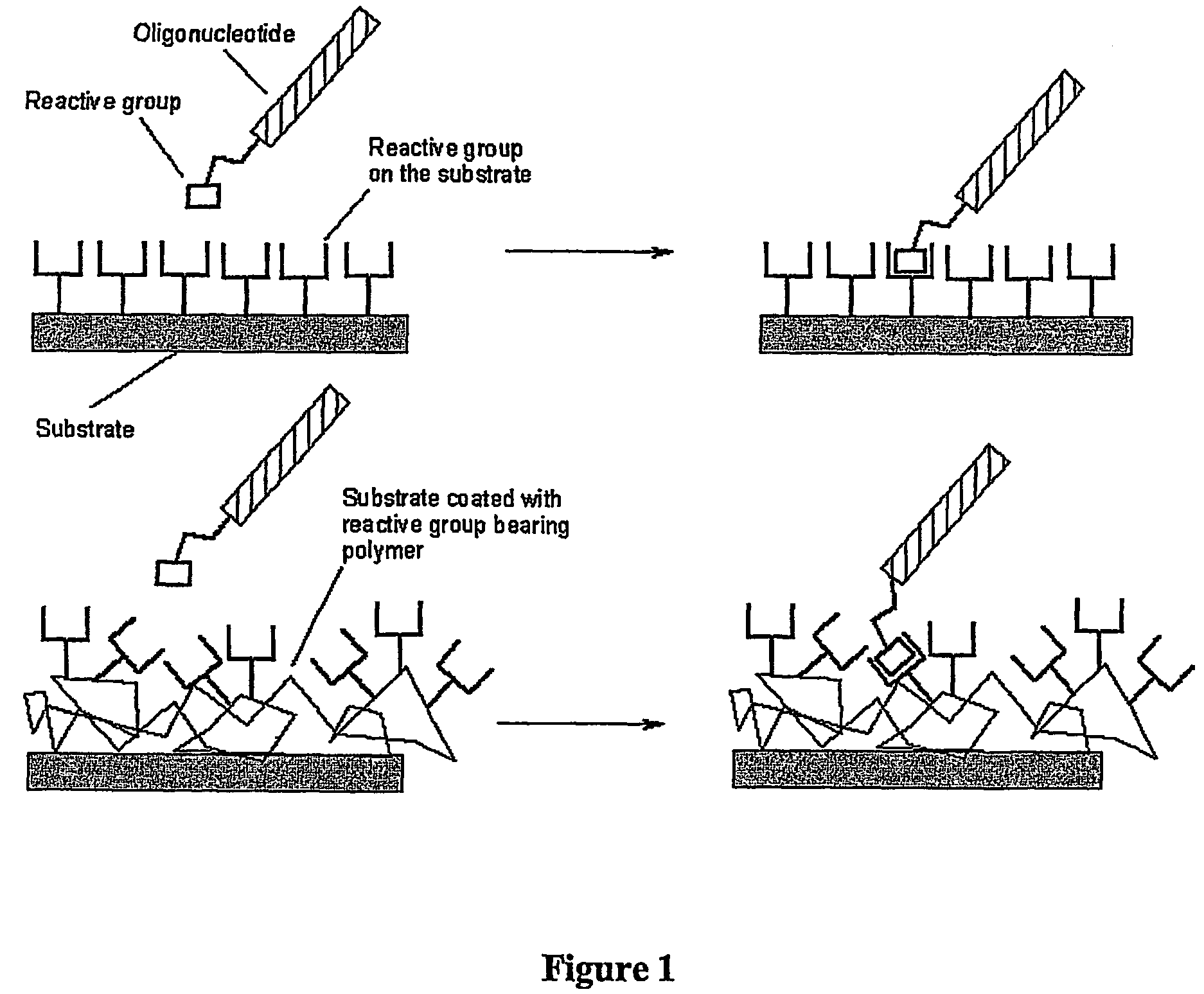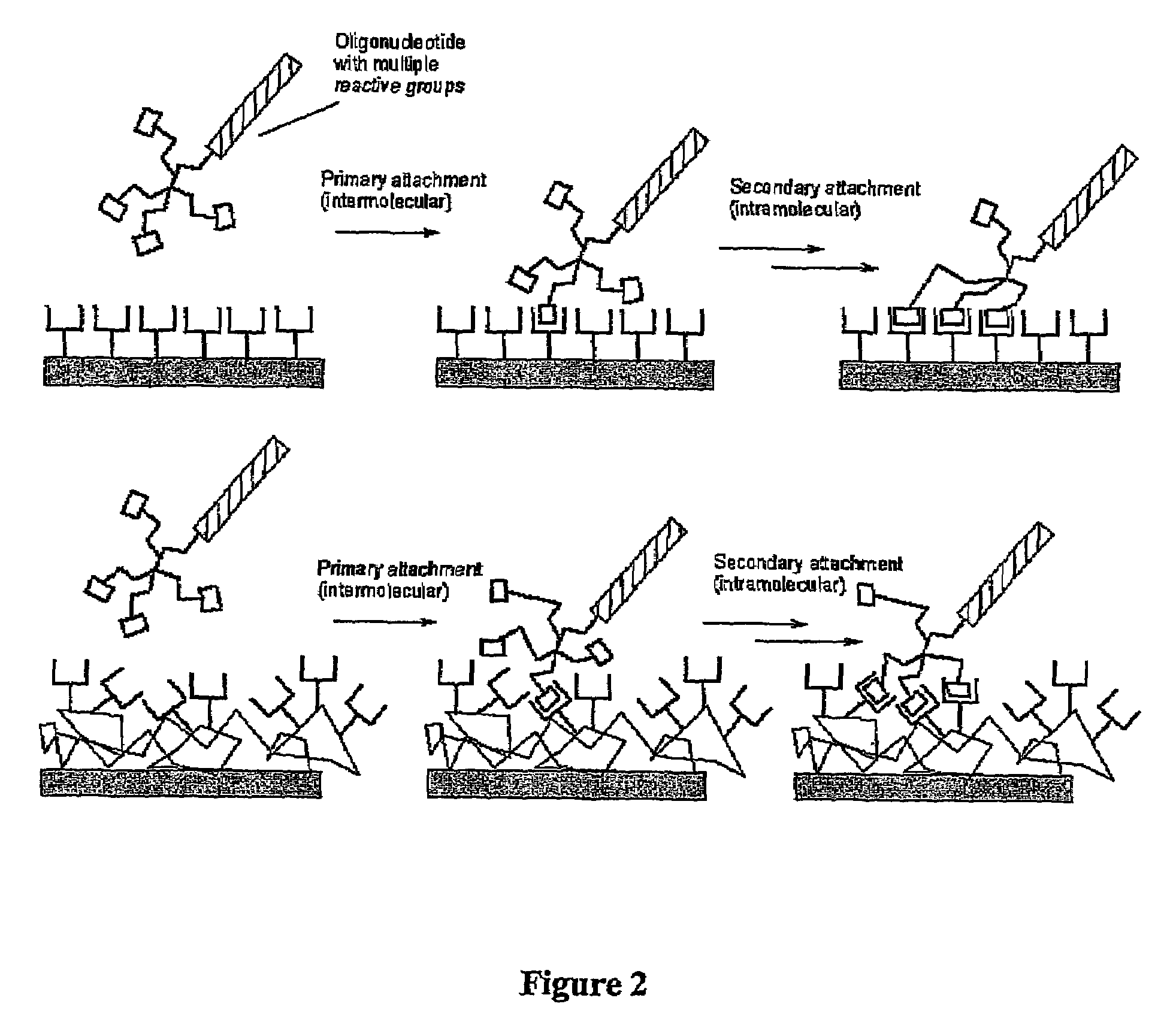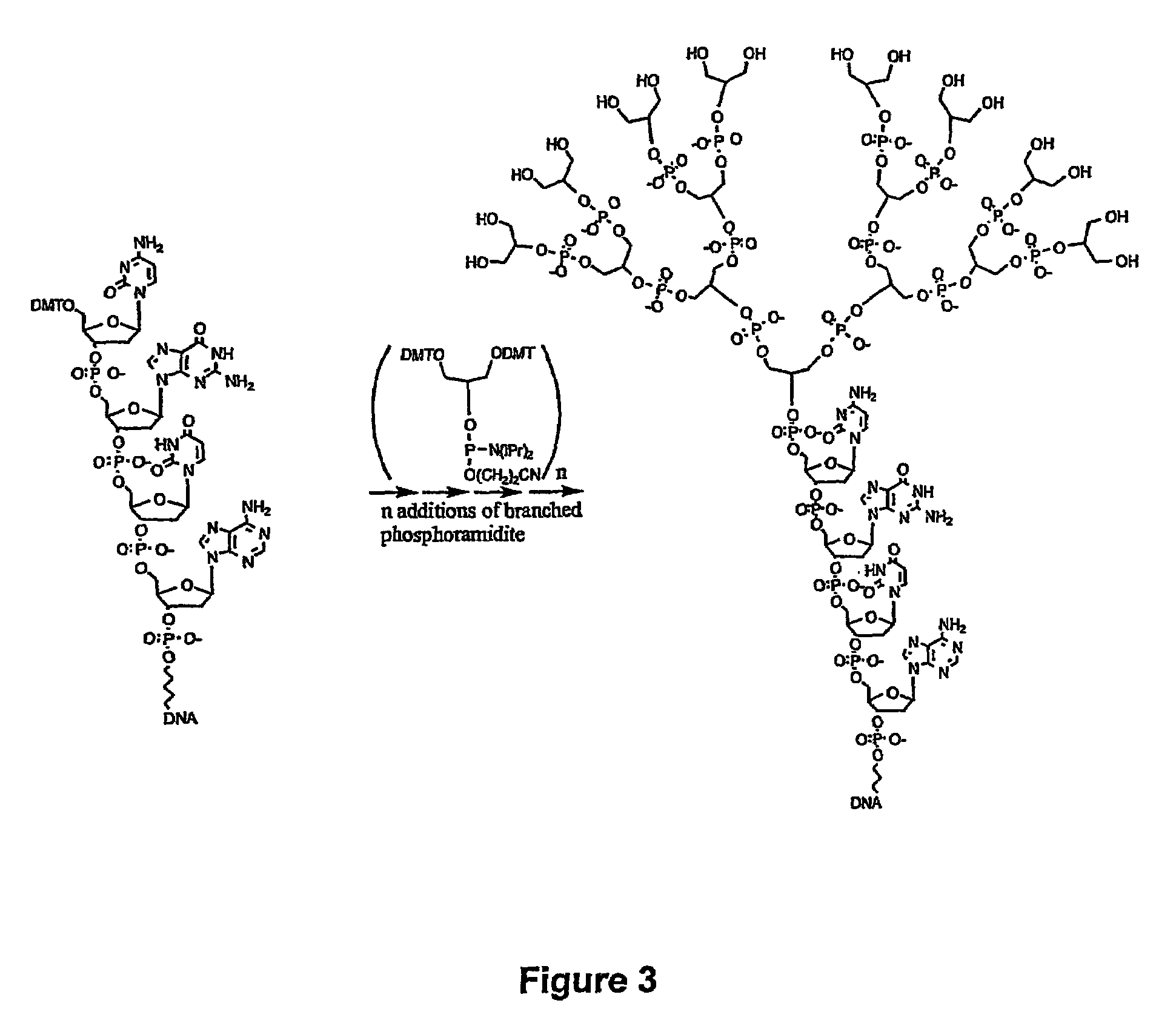Biomolecules having multiple attachment moieties for binding to a substrate surface
a biomolecule and substrate technology, applied in the direction of instruments, group 5/15 element organic compounds, chemical indicators, etc., can solve the problems of increasing the speed of the immobilization process, increasing the cost of stabilization reaction, so as to improve the use of available sites, improve the effect of oligonucleotide loading and improved attachmen
- Summary
- Abstract
- Description
- Claims
- Application Information
AI Technical Summary
Benefits of technology
Problems solved by technology
Method used
Image
Examples
example 1
[0066]Experiment 1.1 Synthesis of N-Triphenylmethyl-6-hydroxycapronic acid hydrazide, (compound 5, FIG. 9A).
[0067]To a solution of 6.2 g (20 mmol) of tritylhydrazine hydrochloride (3a) in 200 ml of THF was added 2.22 g (22 mmol, 1.1 eq) triethylamine. The solution was stirred at room temperature (rt) for 15 min. filtered, concentrated to afford compound 3, then treated with 2.29 g (20 mmol, 1 eq) of ε-caprolactone (compound 4). The mixture is heated to 65° C. for 5 h the cooled to rt for 18 h. The precipitate was collected and recrystallized from ethyl acetate to afford 3.55 g (45%) of a white powder (compound 5):
[0068]1H-NMR 7.49–7.47 (m, 5H), 7.35–7.10 (m, 10H), 6.55 (d, J=7.52, 1H), 5.55 (d, J=7.25, 1H), 3.54 (t, J=6.45, 2H), 1.87 (t, J=7.25, 2H), 1.62 (bs, 1H), 1.57–1.34 (m, 4H), 1.27–1.11 (m, 2H).
[0069]Experiment 1.2
Synthesis of 6-[(2Cyanoethoxy)(diisopropylamino)phosphanyloxy]-N′-tritylhexanohydrazide
(compound 1a, FIG. 9A).
[0070]To a solution of 3.0 g (7.7 mmol) N-triphenylmet...
example 2
[0089]Experiment 2.1 Synthesis of Nonbranched Oligonucleotides
2.1.1 Oligo 9: Hydrazide-15mer: (1-TTT TTT TTT TTT TTT-3′) SEQ ID NO. 1
[0090]The synthesis and deprotection was performed as described with amidite compound 1a. The trityl ON product elutes at 42.2 min under the conditions described. Oligo 9 elutes at 25.6 min (double peak). LRMS (ESI): M calc.: 4709.15, obs.: 4709.5.
2.1.2 Oligo 10: Hydrazide 19mer: (1-dGA TGA GCA GTT CTA CGT GG-3′) SEQ ID NO. 2
[0091]The synthesis and deprotection was performed as described with amidite compound 1a. The trityl ON product elutes at 41.5 min under the conditions described. Oligo 10 elutes at 25.1 min (single peak). HRMS (ESI): M calc.: 6092, obs.: 6092.
2.1.3 In Situ Generation of Hydrazides (Oligo 11; Hydrazide 19mer (8-dGA TGA GCA GTT CTA CGT GG-Cy3) SEQ ID NO. 3
[0092]The synthesis of the oligonucleotide was performed as described previously. A CPG support loaded with Cy3 dye was used to label the fluorophor at the 3′ end of the oligo. The...
example 3
[0118]Upon completion of the synthesis of hydrazide oligos, the first set of experiments examined the solution reaction kinetics of a hydrazide labeled oligo with an NHS or Sulfo-NHS ester. To a solution of 5 uL of 132 uM hydrazide ATA5 in 30 uL of 50 mM histidine was added 5 uL of 10 mM NHS acrylate. The solution was stirred at RT for a short period of time then injected into an HPLC system. The HPLC trace of the compounds in the solution indicated the quantities of hydrazide ATA5 and N′acrylo-ATA5 dihydrazide present in the reaction mixture for a given reaction time. The retention times of the starting ATA5 hydrazide and the modified ATA5 hydrazide were distinct and separable.
[0119]FIGS. 10A–C show three separate traces of the reaction mixture. The first trace (A) was obtained from an unmodified ATA5 hydrazide (A), and the third trace (C) represents a completely modified ATA5 hydrazide (B) after a reaction time of 5 minutes with NHS acrylate. The middle trace (B) repr...
PUM
 Login to View More
Login to View More Abstract
Description
Claims
Application Information
 Login to View More
Login to View More - R&D
- Intellectual Property
- Life Sciences
- Materials
- Tech Scout
- Unparalleled Data Quality
- Higher Quality Content
- 60% Fewer Hallucinations
Browse by: Latest US Patents, China's latest patents, Technical Efficacy Thesaurus, Application Domain, Technology Topic, Popular Technical Reports.
© 2025 PatSnap. All rights reserved.Legal|Privacy policy|Modern Slavery Act Transparency Statement|Sitemap|About US| Contact US: help@patsnap.com



